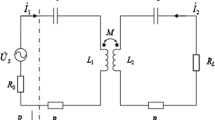Abstract
Magnetic coupled resonant wireless energy transmission technology is a way of wireless energy transmission. In the field of magnetic coupled resonant wireless energy transmission system, the distance between the transmitting coil and the receiving coil is too large and the position is fixed. The system is in the state of under coupling, which causes the system output power to be too small. The case of adding the relay coil between the transmitting coil and the receiving coil is proposed to improve the output power. Considering that the introduction of the relay coil may make the system’s charging state transition from under coupling state to over coupling state directly, the frequency splitting phenomenon is suppressed by adjusting the position of the relay coil, the angle of the rotating relay coil, the output power before and after the measures is changed. The simulation experiment shows that the measures of increasing the relay coil and taking suppression of frequency division to restrain the frequency can greatly improve the output power.
Access this chapter
Tax calculation will be finalised at checkout
Purchases are for personal use only
Similar content being viewed by others
References
Liu, Z., Chen, Z., Lin, X., et al.: Review of research on magnetic coupling resonant wireless power transmission. J. Nanjing Univ. Inf. Sci. Technol. (Nat. Sci. Ed.) 9(1), 1–7 (2017)
Wu, W., Lu, Z., Zhang, H., et al.: Research on dynamic capacity increase and double-circuit capacity increase strategy for buried power cable. J. Northeast. Dianli Univ. 36(5), 7–12 (2016)
Teng, Z., Xu, M., Zhang, L.: Nodes deployment in wireless sensor networks based on improved reliability virtual force algorithm. J. Northeast. Dianli Univ. 36(2), 86–89 (2016)
Liang, K., Wang, J.: A wire structure for making high Q resonant magnetic coupled wireless transmission coils. J. Wuhan Univ. (Eng. Ed.) 48(1), 97–101 (2015)
Khan, S., Choi, G.: Analysis and optimization of four-coil planar magnetically coupled printed spiral resonators. Sensors 16(8), 12–19 (2016)
Zhang, Y., Zhao, Z., Lu, T.: Quantitative analysis of system efficiency and output power of four-coil resonant wireless power transfer. IEEE J. Emerg. Sel. Top. Power Electron. 3(1), 184–190 (2015)
Ahn, D., Hong, S.: A study on magnetic field repeater in wireless power transfer. IEEE Trans. Industr. Electron. 60(1), 360–371 (2013)
Yang, M., Huang, B., Jiang, B., et al.: Real-time prediction for wind power based on kalman filter and suport vector mahines. J. Northeast. Dianli Univ. 37(2), 45–51 (2017)
Li, X., Gong, L., Li, Y.: The influence of coil orientation on the performance of magnetically coupled resonant wireless power transmission system. Sci. Technol. Eng. 17(26), 62–68 (2017)
Zhang, Y., Zhao, Z., Chen, K.: Frequency splitting analysis of four-coil resonant wireless power transfer. IEEE Trans. Ind. Appl. 50(4), 2436–2445 (2014)
Xue, C., Cheng, Z., Zhu, H., et al.: Topology optimization of fault tolerant target monitoring for energy harvesting wireless sensor network. J. Netw. Intell. 2(4), 310–321 (2017)
Acknowledgments
This work was supported by National Natural Science Foundation of China (No. 61501106), Science and Technology Foundation of Jilin Province (No. 20180101039JC and JJKH20170102KJ).
Author information
Authors and Affiliations
Corresponding author
Editor information
Editors and Affiliations
Rights and permissions
Copyright information
© 2019 Springer Nature Switzerland AG
About this paper
Cite this paper
Li, J. et al. (2019). Power Optimization Method of Magnetic Coupling Resonant Wireless Energy Transmission System. In: Pan, JS., Ito, A., Tsai, PW., Jain, L. (eds) Recent Advances in Intelligent Information Hiding and Multimedia Signal Processing. IIH-MSP 2018. Smart Innovation, Systems and Technologies, vol 109. Springer, Cham. https://doi.org/10.1007/978-3-030-03745-1_7
Download citation
DOI: https://doi.org/10.1007/978-3-030-03745-1_7
Published:
Publisher Name: Springer, Cham
Print ISBN: 978-3-030-03744-4
Online ISBN: 978-3-030-03745-1
eBook Packages: Intelligent Technologies and RoboticsIntelligent Technologies and Robotics (R0)




